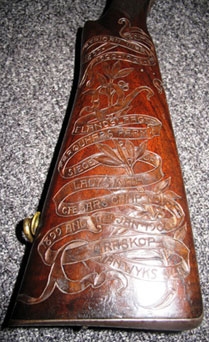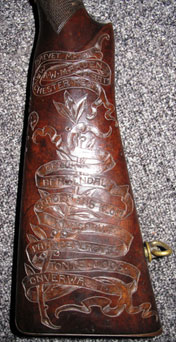Museum of the Manchester Regiment Object Focus
Lee-Speed Sporting Rifle
The following article was originally printed in the Regimental Journal of the King’s Regiment, The White Horse and the Fleur de Lys, in Vol. VII, No.3, Summer 1972, p180.
 “Last year a rare sporting rifle, carried by Major A. W. Marden, DSO, 1st Bn The Manchester Regiment, during the South African War, was presented to us by Major General G. M. F. Deakin CB, CBE, and it is now at Queen’s Park in the Regimental Collection.
“Last year a rare sporting rifle, carried by Major A. W. Marden, DSO, 1st Bn The Manchester Regiment, during the South African War, was presented to us by Major General G. M. F. Deakin CB, CBE, and it is now at Queen’s Park in the Regimental Collection.
Major Marden served throughout the South African War with the 1st Battalion. He was wounded at Caesar’s Camp, Ladysmith and awarded the DSO for services during the campaign.
During this war in the open country of the velt, actions were often fought at long rifle range. It was the custom for British officers to carry special rifles made for them by manufacturers in Great Britain. This Lee Speed sporting rifle is one of these. It shows signs of having been carried for long periods across the back of a man mounted on horseback, because the brass sling swivel is well worn by continued movement. Whether or not the rifle was the equal of the longer barrelled Mausers carried by the Boers is doubtful; certainly it would not match them for accuracy, particularly at long range. However with its flush bolt, short barrel and lightness, it would make a handy weapon for a man in the saddle.
All ranks in the Boer Commandos carried rifles, the most common being the German Mauser. The marksmanship of these farmer soldiers was outstanding, and considerably better than that of our own soldiers. Towards the end of the Boer War and during the years that followed Weapon Training methods were improved in the British Army. Lord Roberts played an important part in this new policy. The accurate rapid fire of the British Army at Mons, which stopped the German Army, showed the progress we had made.
 Examination of the woodwork of this Lee Speed Rifle makes one believe that the original butt was replaced with the carved one after return to Great Britain. It was probably then given an honoured place on display in the Marden household.
Examination of the woodwork of this Lee Speed Rifle makes one believe that the original butt was replaced with the carved one after return to Great Britain. It was probably then given an honoured place on display in the Marden household.
To finish on this subject of the infantry officer and his rifle, the author of this article can well remember Colonel Charles Archdale carrying his own special custom built rifle in Burma during World War II. In these days, with our more sophisticated small arms, the officer has only one choice – the Self Loading Rifle.
Technical description:
.303 sporting rifle based on the Service carbine. It was supplied by the Army & Navy Stores, London and made by BSA Ltd to Lee Speed specifications.
Length overall approx 40in. Heavy, round steel barrel 20 7/8in long. Proved for Cordite with Metford rifling.
Action body and cut off to similar Service carbines, but bolt is similar to the original Lee-Metford rifle pattern without a safety catch. The knob is turned down and flattened as in all Lee Speed sporting rifles and Service carbines. A bolt cover is fitted.
The back sight is the lift up leaf type with the leaf graduated from 600 to 2,000 yds in 100 yard divisions with short lines denoting 50-yard settings. The bed ramp is graduated from 100 to 500 yards (Service carbines are graduated 200 to 500 yards). The foresight is a fine silver bead of normal sporting type and has as a sheet metal protector. The weapon would be sighted for use with normal Mark II ammunition.
Various types of sporting bullets of the expanding type could be procured for use in the Mark II case and as long as they were the same weight as the Service bullet, would not affect the sighting.
The magazine is of the normal sporting shape and will hold 5 rounds (Service magazines hold 6 rounds).
The stock is in good quality walnut with a short, well chequered fore end and a nicely chequered butt with a top safety slide which prevents the rear moving downwards out of the full cock bent when on SAFE. It is non-automatic. The butt plate is steel, which was normal with sporting rifles, and the trap is larger in diameter than the Service type”.
Who was the owner, Major A. W. Marden?
Arthur William Marden was born on 21 September 1868, the son of Thomas Marden, of Weston Priory, Bath. He joined the Manchester Regiment on 11 February 1888 as a Second Lieutenant; became Lieutenant on 31 July 1889, appointed Adjutant of the Manchester Regiment on 18 April 1896 to 1 November 1896, and was promoted to Captain on 6 October 1896.
He served in the South African War (1899-1902) as Adjutant of the 1st Battalion Manchester Regiment (21 October 1899 to 1 March 1900 and 14 May to 29 November 1900). He took part in the operations in Natal (1899) including actions at Elandslaagte, Lombard's Kop and Defence of Ladysmith, including action of 6 January 1900 when he was slightly wounded.
He was again in Natal (March to June 1900). He serve in the Transvaal, east of Pretoria, July to 29 November 1900, including action at Belfast (26 and 27 August), and again during operations in the Transvaal (1901).
He was Twice Mentioned in Despatches and was given the Brevet of Major on 1 June 1902. He received the Queen's South African medal with three clasps, and the King's South Africa medal with two clasps.
He was created a Companion of the Distinguished Service Order (DSO) (London Gazette: 31 October 1902):
"Arthur William Marden, Captain and Brevet Major, Manchester Regiment. In recognition of services during the operations in South Africa".
He became a Major on 29 November 1900, retiring from the Manchester Regiment 22 April 1911.
He was given the Brevet of Lieutenant Colonel, and was promoted to Colonel in the Army on 19 October 1917. Arthur married, in 1903, Laura Elizabeth, daughter of Joseph Deakin, of Ellerhow, Grange-over-Sands.
What did the names engraved on the butt of the rifle mean?
These are the battles that Arthur took part in during the Boer War.


Do you want to learn more about Arthur William Marden?
More information about Arthur can be found in Tameside Local Studies and Archives Centre at MR1/3/1/4, MR1/16/5/6 and MR1/16/5/23. Please click here for more information about Tameside Local Studies and Archives Centre.
This article was research and compiled by Ms Emily Dutton while on placement at the Museum of the Manchester Regiment during April 2011.

